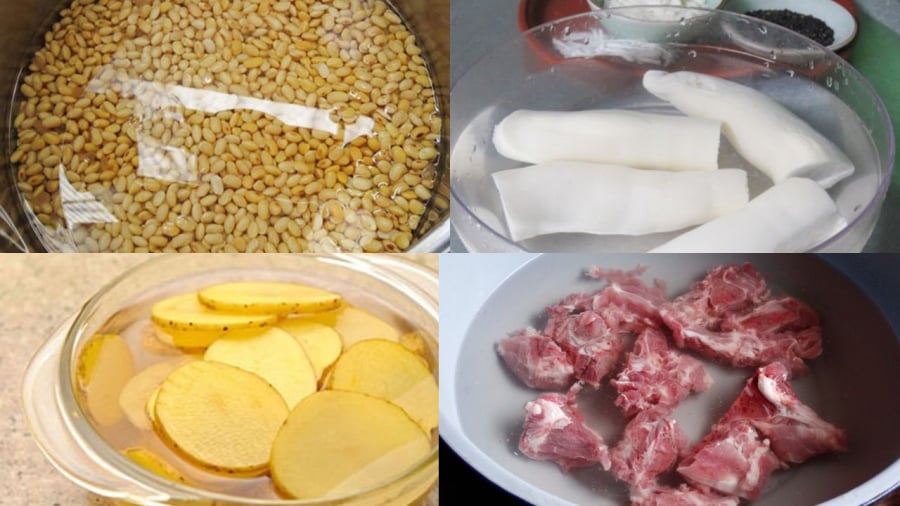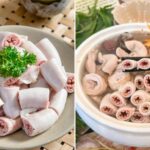For those who grew up in the 80s or earlier, you might recall a familiar scene from your childhood homes: whenever our elders prepared potatoes, cassava, or beans, they would soak them in water for half an hour to overnight before cooking. Have you ever wondered if this practice was merely to prevent discoloration or if there was a deeper significance to it?
In fact, soaking foods before cooking does more than just enhance their appearance and texture; it also plays a crucial role in removing toxins and improving food safety—a traditional practice that has been scientifically validated in modern times.
1. Soaking potatoes, cassava, and fresh bamboo shoots to eliminate natural toxins
Potatoes – Soaking to remove solanine: Potatoes are tubers that grow underground, but when exposed to light, they can turn green, indicating the presence of high levels of solanine, a toxic compound. Even regular potatoes contain alkaloid acrylamide and small amounts of solanine, which can be harmful to health. Soaking potatoes for at least 30 minutes in cold water after peeling and slicing will help eliminate most of the toxins and prevent oxidation, which causes discoloration. This is why, traditionally, soaking potatoes before cooking has been a common practice.

Cassava – Removing harmful cyanide: Cassava, also known as manioc or yuca, contains significant amounts of cyanide, an extremely toxic substance. Eating raw cassava or improper preparation can lead to severe poisoning and even death. Therefore, it is necessary to soak cassava for 2-3 hours, changing the water multiple times, to reduce the cyanide content. It is also important to peel the cassava and remove the ends and core, as these parts contain the highest concentration of toxins.
After soaking, cassava should be boiled thoroughly with the lid off to allow toxic compounds to escape as steam.
Fresh bamboo shoots – Soaking is essential to prevent poisoning: Like cassava, fresh bamboo shoots also contain cyanide and must be thoroughly soaked, boiled multiple times, and rinsed repeatedly to break down and remove the toxin. Failing to do so can lead to acute poisoning. When boiling bamboo shoots, leave the lid slightly ajar to allow the toxin to escape more easily.
2. Soaking grains and legumes to enhance nutritional value and inhibit anti-nutrients
Why soak rice, beans, and other legumes? Grains like brown rice, soybeans, black beans, green beans, and almonds contain enzyme inhibitors (antinutrients) that prevent premature sprouting. However, these substances can interfere with the absorption of minerals and vitamins during digestion.
Soaking these foods for several hours or overnight not only softens them, making them easier to cook, but also helps remove most of the anti-nutrients, allowing the body to absorb more of the beneficial nutrients.
Of special note are rice and brown rice: the bran layer of rice, especially brown rice, may contain natural arsenic from the soil and water. Soaking and thoroughly rinsing rice before cooking can significantly reduce arsenic levels, contributing to long-term health.
Without prior soaking, some of these legumes can cause bloating, indigestion, and even stomach pain in individuals with sensitive digestion. Soybeans and black beans, in particular, should be thoroughly cooked after soaking to ensure safety.
3. Soaking bones – The secret to clear and odorless broth
When preparing broth from pork, beef, or chicken bones, a small but effective tip is to soak the bones in cold water for 30-60 minutes before blanching. This step helps remove excess blood and marrow, cleans the bones, and reduces the risk of a strong odor during simmering.
Blanching and rinsing the bones after soaking will result in a clear, fragrant broth, free from cloudiness and unpleasant odors—a trick employed by many experienced cooks and chefs.
Additionally, some fruits, such as mangoes and eggplants, benefit from soaking before consumption to eliminate certain undesirable compounds.
Conclusion: A Small Practice, A Big Impact
There is a reason why our ancestors passed down the tradition of soaking foods before preparation. Now, with scientific validation, we have an even stronger understanding that proper soaking not only enhances the taste and appearance of our dishes but also ensures the safety and well-being of our loved ones.
Let’s embrace this simple yet impactful practice in our daily cooking routines, as sometimes, it’s the little details that make the biggest difference in safeguarding our families’ health.
“7 Creative Uses for Expired Yogurt: Don’t Toss It, Transform It!”
Introducing a new way to look at expired yogurt: don’t discard, repurpose! Imagine having a secret weapon in your fridge that can tackle a multitude of household woes. That’s right, expired yogurt can be a handy helper around the home. With its unique properties, it can be transformed into a versatile problem-solver. So, before you toss that yogurt, consider the endless possibilities it holds.






































